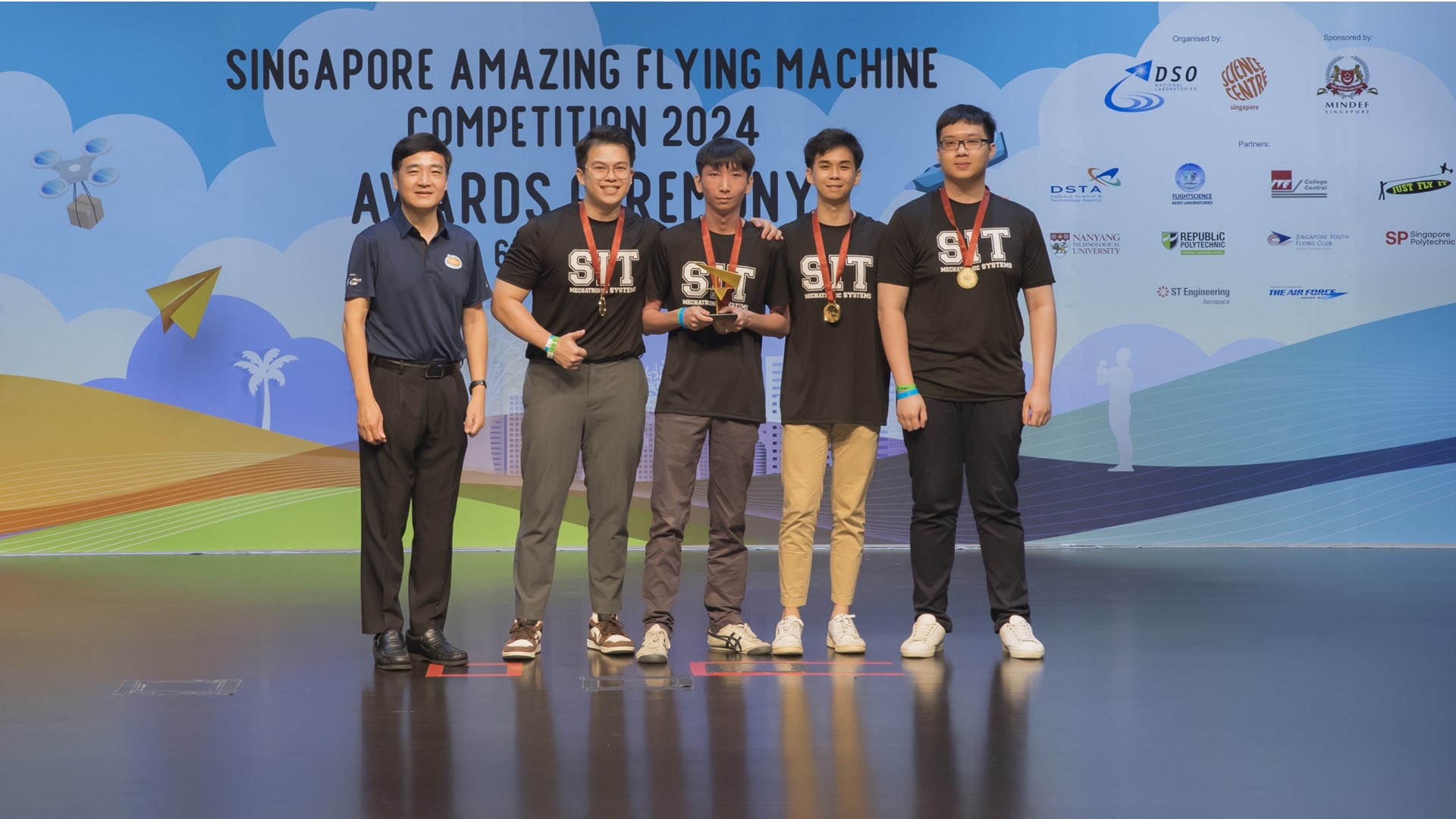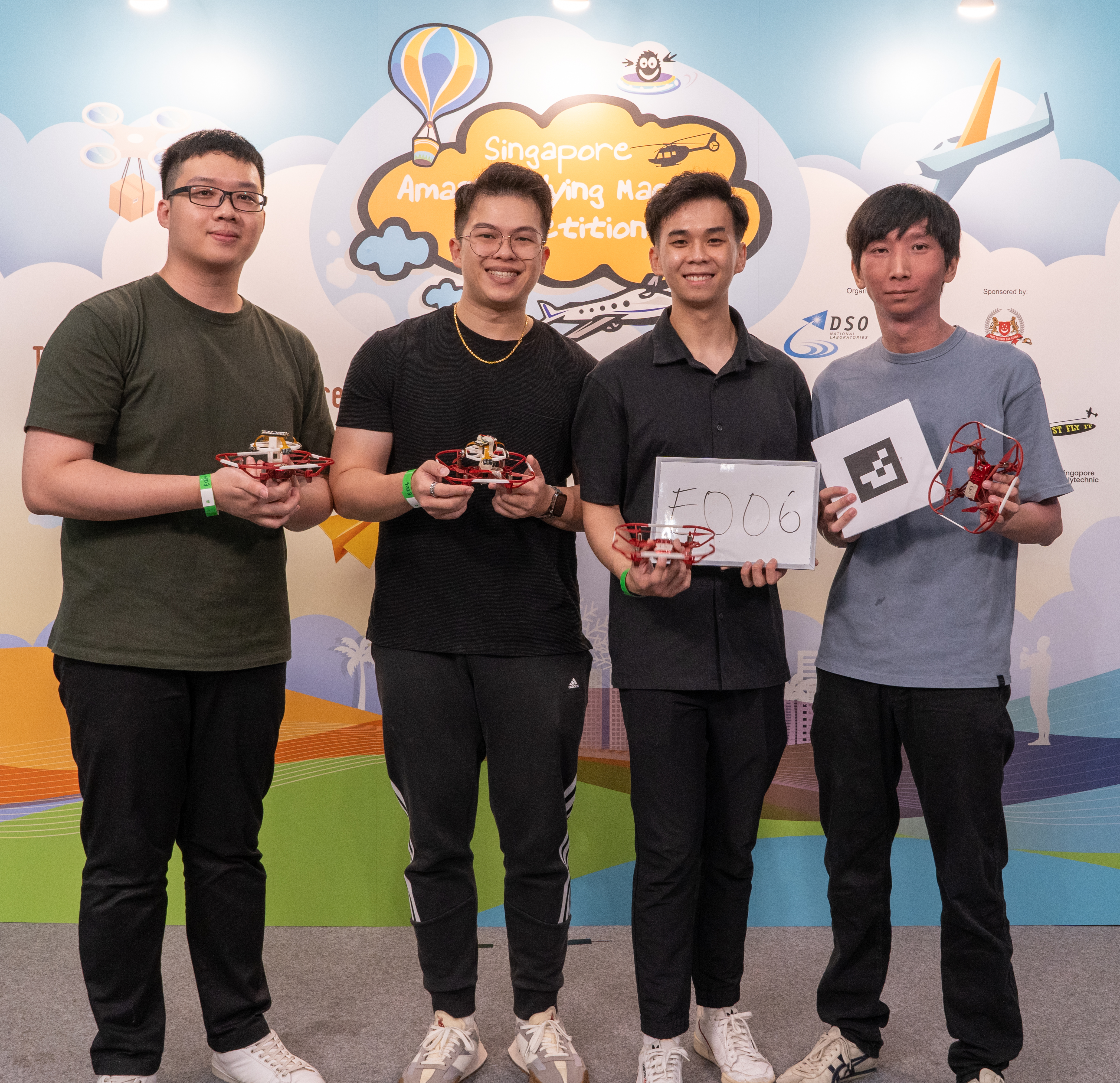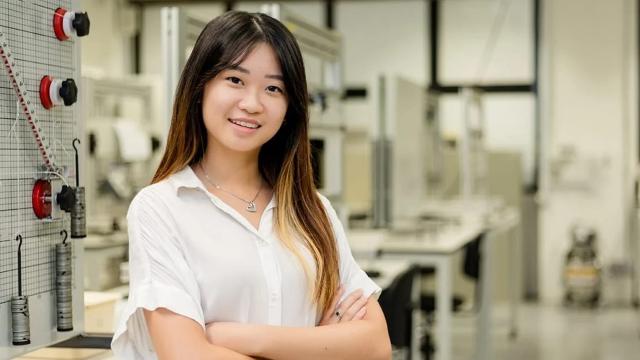
The SIT team with Senior Minister of State for Defence Heng Chee How at the Singapore Amazing Flying Machine Competition 2024 Awards Ceremony. From left: SMS Heng, Dyner Wong, Tan Wei Xuan. Kevin Lok, Lee Kang Jie. (Photo: DSO National Laboratories)
Learning about ants was the last thing on Kevin Lok’s mind. But when he stumbled onto YouTube channel AntsCanada’s videos, the Year 4 Mechatronic Systems degree programme student at the Singapore Institute of Technology (SIT) was amazed by how ant colonies could effortlessly find food in unfamiliar terrain.
Kevin and his teammates represented SIT in the Swarm category in the Singapore Amazing Flying Machine Competition (SAFMC) 2024 on 6 April, where participants must programme a group of drones to look for “victims” in a simulated search-and-rescue mission without direct human control. Watching the ants, Kevin wondered if he could design a similar algorithm for the drones, to enable them to work smartly in a decentralised yet coordinated manner. It turned out to be a winning move – the team emerged champions in the Swarm category, bagging a cash prize of $20,000.
Explaining the inspiration behind the strategy, Kevin, who leads the competition team, said, “As the worker ants explore and forage for food, they leave pheromone trails that lead them back to the colony. If they find a food source, they reinforce the pheromone trail on their return journey. Since ants communicate primarily through pheromones, the strongest pheromone trail would guide other ants to the food source. We took inspiration from this decentralised behaviour.”
Decentralised systems in swarm technology already work in a similar fashion. “However, the difference is that ant colonies can make decisions so that there is no single point of failure, something drones could not achieve,” he added. This was also the challenge the team had to tackle – to programme the drones to communicate with each other.
The Sky’s the Limit
Over the next eight months, Kevin and his teammates Tan Wei Xuan, Dyner Wong, and Lee Kang Jie, fellow Year 4 Mechatronic Systems SITizens, worked to design a system of 14 intelligent drones that can “speak” to one another to make decisions collaboratively. The team battled challenges such as technical failures, erroneous codes, and even occasions where their drones physically broke apart.
It also led them to discover that the simplest solution is often the best – in their case, the humble masking tape was the crucial item holding their drones in place. “We found that masking tapes could solve 90 per cent of their problems. For example, tying loose wires and securing propellers and mechanical components were all solved by putting more masking tape”, Wei Xuan said with a laugh.
The SIT team observed the drone swarm performing the search-and-rescue mission from a graphical user interface they developed for the competition. (Photo: DSO National Laboratories)
With all the prep work done, the SIT team was ready to tackle the unfamiliar terrain of the Science Centre Singapore, where the SAFMC was held. In a 20m-by-20m playing field with 3m-high walls, the team set off their drones in search of “victims”. Midway through the mission, two of the 14 deployed drones failed and had to be removed from the playfield. Adding to the tension was the fact that participants could not benchmark their performance against their competitors, as they were not allowed to view the other teams at work.
In the end, not only did the SIT team defeat nine other teams, it also garnered a near-perfect score for the mission and is the first team in the competition's history to successfully locate all the “victims” in the search-and-rescue mission.
Factors for Success
Despite the success, participating in SAFMC, which is organised by Singapore’s largest defence research and development organisation DSO National Laboratories, was initially not part of the quartet’s plans. They had originally been working together on a final-year project using drone swarms to pinpoint the source of gas leaks. Their project supervisor, Associate Professor Paw Yew Chai, saw great potential in the project and suggested they give SAFMC a shot.
“The team has demonstrated great confidence, grit and technical skills in solving their complex project tasks. The SAFMC competition offers a fantastic opportunity for them to unleash their limitless potential and scale even greater heights,” said A/Prof Paw, Programme Leader for the Mechatronics Systems degree programme.
While starting on a project of such magnitude was tough, SIT’s applied learning approach made the task a little less daunting. The multidisciplinary Mechatronic Systems degree programme had exposed them to different engineering fields, including mechanical, electrical, and software, said Wei Xuan.For example, System Engineering Project (SEP), a core module taught in three parts, honed their ability to work in teams to design and build a functional engineering system from scratch. “We all agreed that SEP was the foundation, as it was a very hands-on module,” said Kevin. “It acted as a quick primer for our project.”

Champion team for Category E from SIT. (Photo: DSO National Laboratories)
Their biweekly review sessions with project supervisors A/Prof Paw and A/Prof Wee Liang Boon were also helpful. The duo offered guidance and advice that helped them solve design and coding roadblocks.
In particular, A/Prof Wee’s research papers on swarm technology helped Kevin code the drone’s swarm search and exploration algorithm. “We made adjustments based on the algorithm and implemented it in our way,” he said.
Paying It Forward
The group hopes that their pheromone-inspired algorithm will add to the growing body of work and research around smart swarm deployment and communication for drones. With the interest surrounding swarm technology, they hope that in time, swarm drones will play a crucial role in search-and-rescue missions. Wei Xuan, who was also in the winning team of last year’s SAFMC, will be joining DSO National Laboratories to further his interest in robotic systems.
“Swarm drones can cover large areas and simultaneously perform preliminary sweeps of the disaster area,” said Dyner. “This will make missions safer and less time-consuming without putting the rescuer’s life at risk.”
The team is keen to impart their knowledge of swarm technology and the insights they have gleaned from the competition to like-minded juniors from SIT. Since their win, the four have met with a few juniors who are interested in the SAFMC to share their experience.
To his juniors, Wei Xuan has a word of advice, “The key to developing any complex system is repeated testing and validation. Due to many complex and often unpredictable interactions between components, it is impossible to anticipate and account for every possible failure mode. There is always something that can go wrong, and the only way to find out is to test your system repeatedly till it works.”
![[FA] SIT One SITizen Alumni Initiative_Web banner_1244px x 688px.jpg](/sites/default/files/2024-12/%5BFA%5D%20%20SIT%20One%20SITizen%20Alumni%20Initiative_Web%20banner_1244px%20x%20688px.jpg)

